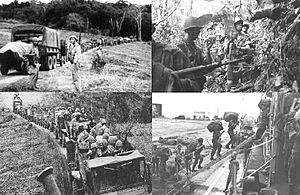Portuguese Colonial War facts for kids
Quick facts for kids Portuguese Colonial WarGuerra Colonial Portuguesa |
|||||||||
|---|---|---|---|---|---|---|---|---|---|
| Part of the Decolonisation of Africa and the Cold War | |||||||||
 |
|||||||||
|
|||||||||
| Belligerents | |||||||||
|
Supported by:
|
|||||||||
| Commanders and leaders | |||||||||
| Generally: Angola: Portuguese Guinea: Mozambique: | Angola:
Portuguese Guinea:
|
||||||||
| Strength | |||||||||
|
148,000 European Portuguese regular troops
|
40,000–60,000 guerrillas +30,000 in Angola
|
||||||||
| Casualties and losses | |||||||||
|
|
||||||||
Civilian casualties:
|
|||||||||
The Portuguese Colonial War (in Portuguese: Guerra Colonial Portuguesa) was a long fight. It happened between 1961 and 1974. Portugal's army fought against groups in its African colonies. These groups wanted their countries to be independent.
The war took place in three main areas: Angola, Guinea-Bissau, and Mozambique. In Angola, Portugal fought against groups like the MPLA, FNLA, UNITA, and FLEC. In Guinea-Bissau, they fought the PAIGC. In Mozambique, they fought FRELIMO.
Contents
What Was the Portuguese Colonial War?
The Portuguese Colonial War was a series of armed conflicts. It happened when Portugal tried to keep its colonies in Africa. Many African people wanted to rule themselves. They no longer wanted to be controlled by Portugal.
This war is also part of a bigger historical event. It is known as the Decolonisation of Africa. This was a time when many African nations gained their freedom. The war also happened during the Cold War. This was a period of tension between powerful countries.
Why Did the War Happen?
For a long time, Portugal had colonies in Africa. These included Angola, Mozambique, and Guinea-Bissau. Portugal's government, called the Estado Novo, believed these colonies were part of Portugal itself. They did not want to give them up.
However, people in the African colonies felt differently. They wanted to be free and govern their own countries. They formed groups called nationalist movements. These groups started fighting for their independence.
Who Fought in the War?
On one side was the country of Portugal. Their military fought to keep control of the colonies. Portugal also received some support from countries like South Africa and Rhodesia.
On the other side were the African nationalist movements. These groups included:
- In Angola: The MPLA, FNLA, UNITA, and FLEC.
- In Guinea-Bissau: The PAIGC.
- In Mozambique: The FRELIMO.
These African groups received help from many countries. This support came from places like the Soviet Union, Cuba, China, and even the United States. Other African nations also helped. These included Zaire, Algeria, and Tanzania.
Key Leaders During the Conflict
Many important people led the fighting on both sides.
- For Portugal, leaders included António de Oliveira Salazar and Marcelo Caetano. They were the prime ministers of Portugal. Generals like António de Spínola also played big roles in the colonies.
- For the African movements, there were figures like Agostinho Neto (Angola), Amílcar Cabral (Guinea-Bissau), and Eduardo Mondlane (Mozambique). These leaders inspired their people to fight for freedom.
How Did the War End?
The Portuguese Colonial War lasted for 13 years. It was very costly for Portugal. Many soldiers were sent to Africa. The war also caused problems within Portugal.
In 1974, something big happened in Portugal. It was called the Carnation Revolution. This was a peaceful military takeover. It ended the Estado Novo government. The new government in Portugal decided to end the wars. They agreed to give independence to the African colonies.
What Happened After the War?
After the Carnation Revolution, the African colonies quickly became independent countries.
- Angola became independent in 1975.
- Guinea-Bissau became independent in 1974.
- Mozambique became independent in 1975.
- Cape Verde and São Tomé and Principe also gained independence.
However, independence did not always bring peace right away. Some of the newly independent countries faced civil wars. These wars were often between the different nationalist groups that had fought for freedom.
Related pages
- Angolan War of Independence (1961–1974)
- Guinea-Bissau War of Independence (1963–1974)
- Mozambican War of Independence (1964–1974)
- Angolan Civil War (1975–2002)
- Mozambican Civil War (1977–1992)
Images for kids
-
Cabo Verdean and Bissau-Guinean revolutionary Amílcar Cabral. He studied agronomy in Lisbon.
-
Portuguese Army soldiers at the start of the War in Angola. Their uniforms show they were Caçadores Especiais.
-
The Portuguese Air Force used Fiat G.91 aircraft in the war.
-
SKS semi-automatic rifles were also used by guerrillas.
-
A monument in Coimbra, Portugal, honoring the heroes of the Portuguese Overseas Territories.
-
A monument in Lisbon to Portuguese soldiers who died in the Overseas War.
See also
 In Spanish: Guerra colonial portuguesa para niños
In Spanish: Guerra colonial portuguesa para niños






















